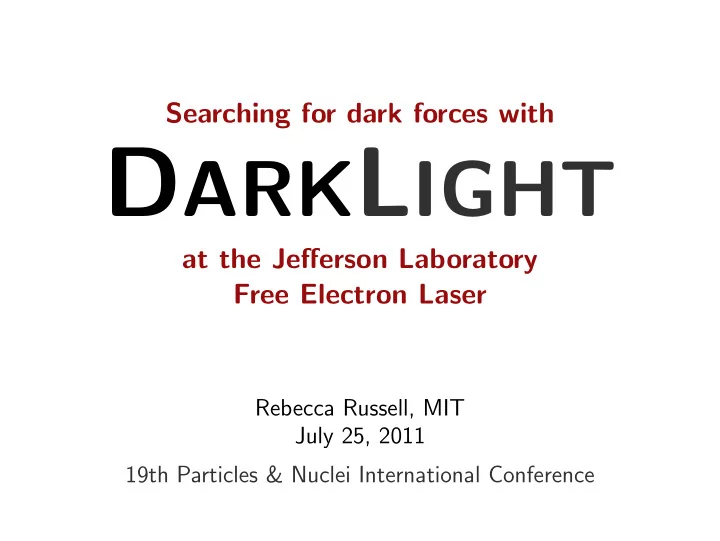

Searching for dark forces with D ARK L IGHT at the Jefferson Laboratory Free Electron Laser Rebecca Russell, MIT July 25, 2011 19th Particles & Nuclei International Conference
What are dark forces? The universe appears to be filled with cold dark matter, which could be a relic particle that interacts only though Weak force Gravitation . . . forces beyond the Standard Model? COSMOS dark matter distribution NASA, ESA, P. Simon and T. Schrabback
Dark matter annihilation Indirect detection of dark matter: Annihilation products in cosmic radiation? WMAP haze : Excess microwave emission around galactic center Synchrotron radiation from relativistic electrons and positrons? PAMELA / HEAT / AMS-01 / ATIC / Fermi / HESS : Cosmic positron excess High positron fraction in 10-100 GeV range PAMELA Collaboration, Nature 458 (2009) 607-609.
A possible explanation Positron excess orders of magnitude larger than what is allowed by thermal relic abundance – even including SUSY neutralino Large cross section into leptons but low cross section into hadrons – PAMELA antiproton results and measurements of galactic gamma rays New force in the dark sector can simultaneously explain all of these anomalies Sommerfeld enhancement of low-mass interaction increases annihilation cross section at low velocities Suggests a sub-GeV scale boson ‘heavy photon’ A ′
Experimental bounds on A ′ Low-mass, high-coupling region of parameter space Beam dump axion searches in the 1980s at Fermilab and SLAC A ′ contribution to the anomalous magnetic moments of leptons . . . a µ currently disagrees with the SM by 3.4 standard deviations!
DarkLight The DarkLight experiment will search in this very interesting low-mass region of parameter space – including the vast majority of the region preferred by the current value of a µ Fixed target experiment, with 100 MeV electrons incident on a hydrogen target – interactions below pion threshold DarkLight will look for direct A ′ production and decay into an electron-positron pair in electron-proton scattering
A ′ production Dark forces in e − p → e − p e + e − scattering e − e − e − ✁ A ′ ✁ e + e − A ′ e + p p Select only events with an extra electron positron pair Invariant mass gives the mass of the dark force boson – straightforward way to search for the A ′
Irreducible background e − e − e − γ ✁ ✁ e + e − e + p p e − ✁ e − p e + All of these QED processes are indistinguishable from A ′ production and decay!
Irreducible background At this low energy energy, QED background events are more than 4 orders of magnitude more common Signal appears as narrow resonance on huge, smooth QED background → Huge luminosity required
The JLab FEL The Jefferson Lab free electron laster (FEL) is the only currently-operating FEL using a continuous wave superconducting energy recovering linac The FEL linac provides a unique high-intensity electron source
The FEL and DarkLight The DarkLight apparatus could replace the UV undulator in the current FEL setup FEL would be run at a low energy of 100 MeV, low charge of 10-20 pC per bunch, and high repetition rate of 750 MHz → 10 mA beam current
Experimental design Basic DarkLight design: A compact solenoidal detector surrounding a windowless hydrogen gas target Differential vacuum pumping system (50 Torr-liter/s of hydrogen gas) for target with 10 19 atoms/cm 2 1 Tesla longitudinal magnetic field to contain Møller scattered electrons and provide 1 MeV energy resolution Detection of 10-100 MeV electrons/positrons and 1-5 MeV recoil protons Full 4-particle event reconstruction
Experimental design
Reach 1 month of running provides 1 ab − 1 integrated luminosity Covers most of the a µ preferred region Complementary to other planned experiments
Timeline Letter of Intent submitted in January 2010 Proposal submitted to Jefferson Lab in November 2010 and considered by PAC 37: DarkLight approved conditional upon completion of design Design in progress – anticipate completion early in 2012 Program of tests with FEL beam being prepared right now
Recommend
More recommend